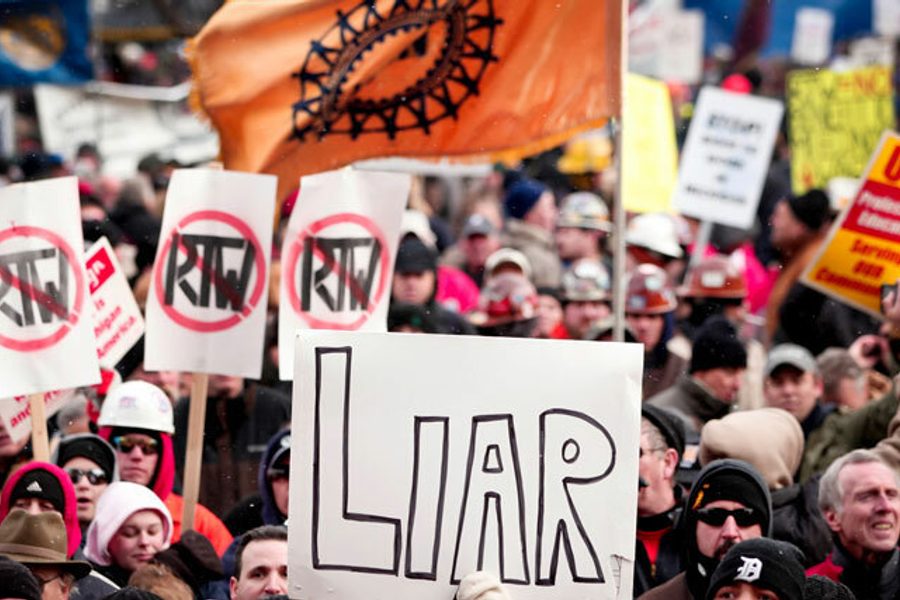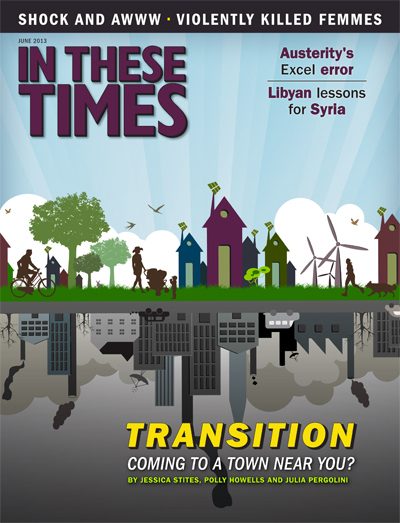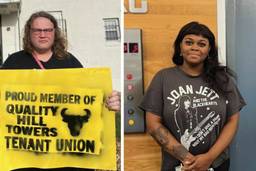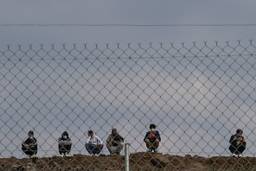Where Unions Went Wrong on ‘Right to Work’
Labor activists retool their tactics against the bosses.
Rebecca Burns

When Michigan became the 24th state in the nation to pass “right-to-work” legislation this March, local union leaders immediately swore to overturn the misleadingly named laws, which threaten unions’ solvency by letting workers who receive the benefits of union representation opt out of paying dues. In January, the state’s unions filed a lawsuit seeking to invalidate right-to-work legislation, and labor has also vowed to step up campaigns against Michigan Gov. Rick Snyder and other anti-union state leaders in advance of the 2014 elections.
In this crisis, some in labor also see an opportunity. Faced with a wave of new restrictions, some unions have begun to adopt a more confrontational, less legalistic mode of organizing that relies more heavily on collective action than on formal collective bargaining. They hope this approach can also revive labor in an era that has seen unionization in the United States sink to its lowest level since 1916. In These Times spoke to three labor organizers about how to respond to the advancing tide of right-to-work laws. Joining the conversation were activist and writer Bill Fletcher Jr.; Cindy Estrada, vice president of the United Auto Workers; and Rand Wilson, communications and policy director at SEIU Local 888.
For a long time, right-to-work laws were confined to the South, but following ratification in Michigan, right to work now appears poised to pass in Pennsylvania. What kind of efforts are underway to stop this metastasis?
Bill: We have to keep hammering away at a very basic point: What’s really at stake here is the right to be greedy. It’s the statutory obligation of a union to represent all workers, irrespective of whether they’re union members. That costs money, and the right wing knows that. So, what they’re looking for is to weaken us by getting us to use up our resources. This would be the equivalent of allowing citizens of a city to voluntarily pay taxes, but at the same time receive education, fire and police services.
Cindy: There’s a legal challenge underway [alleging that the laws were passed in violation of Michigan’s Open Meetings Act] because on the day they voted on right to work in Michigan, they kicked everyone out of the Capitol.
I really hope this won’t be just a legal fight for us, though. What’s exciting about this moment is that we have an opportunity to learn from our mistakes. One mistake we made in Michigan was that the governor basically lied to us and told us right to work wasn’t on his agenda, and we believed him.
Bill: And labor has missed a number of other opportunities [to challenge right to work]. There has been a strategic failure of the union movement to really concentrate on organizing the South and the Southwest, and the leaders of our movements in other parts of the country assumed that they would be impervious to the assault from proponents of right to work. Now, I think we’re facing the very real prospect that the entire country could become right-to-work.
What’s the big picture for unions? Will Michigan see a decline in its relatively high, nearly 17 percent unionization rate?
Cindy: In terms of UAW, we’re anticipating that there may of course be some workers who will choose to not pay dues. But overall, we don’t expect to lose a lot of members. We’re organizing internally, and we have a lot of units where contracts aren’t up for another year and a half, so we have time to really help people understand the importance of keeping a strong union in their workplace.
Rand: All of our experience elsewhere so far suggests that membership and the resulting dues decline significantly [as a result of right-to-work legislation]. As unionized workers become a smaller and smaller minority of the overall working class, that makes it harder and harder to defend collective bargaining rights. Hopefully we recognize that in order to survive, we have to change.
On that note, do you think unions should be putting all their energy into challenging these laws, or should they be adapting their strategies?
Rand: You have to do both. You have to fight back. I hope people will pursue a repeal effort in Michigan. The referendum in Ohio [which restored collective bargaining rights to state employees in November 2011] was a dramatic example of how you can win such an effort.
At the same time, I think this is an opportunity to revive the organizing model, as opposed to the servicing model, of union representation. In right-to-work states, union organizers have been contending with these issues for a long time, and there we see a very different, more confrontational model of unionism. In a right-to-work environment, unions aren’t going to be as orderly or as complacent as employers have been used to. That’s the downside for the bosses of pushing through all these punitive measures.
Left labor critics have long argued that dependence on automatic dues deduction makes unions less responsive to workers. Is there also an opportunity, in responding to right to work, to revive internal democracy in union shops?
Rand: Dues deduction has perhaps led to some complacency. But the problem is not dues deduction; it’s a broader political one of how members conceive of themselves and their class position. That will require us to engage much more in member-to-member union building and internal education.
Bill: If we’re going to be honest, most of the leaders of organized labor don’t take internal education seriously. What passes for internal education is PowerPoints, rather than real dialogue and debate. So it shouldn’t surprise us that people feel alienated. I think we have to rethink internal education and discussion with our members around the big picture of why working people are getting their rear ends kicked.
Cindy: An important part of internal education is getting members to understand that it’s not just about the facility where they work — it’s also about the community they live in and how they can effect change there. That’s more challenging. One of the ways that we’re doing it in the UAW is by working with other groups in the city of Detroit and around Michigan on the issues of foreclosures and immigration reform.
The battles to defend collective bargaining rights in Wisconsin and Ohio have helped reenergize the movement. But how could labor start going on the offense?
Rand: If you’re always on defense, you’re guaranteed to go backwards. We’re losing ground on wages, healthcare and pensions. So it might be sensible, with the resources that we have left, to start moving toward something that would make employers start to play defense. While it might not be achievable in the near term, a campaign for new workplace protections around due process and just cause for termination is an idea that would resonate with almost all workers.
Bill: Back in the mid ’80s, when I was living in Boston, Rand and I were actually involved in an effort to do precisely what he’s talking about: introducing a campaign around just cause. And what often happened was that unions opposed this, on the grounds that if you give that right to people in general — not just union members — then people wouldn’t want unions. So part of what we have to understand is that we need to be a movement that is fighting for rights at work, irrespective of whether or not there’s a union there.
What kind of changes within the labor movement would need to take place in order for this to happen?
Cindy: I think that our fight needs to be on the ground, in coalition with a broad range of groups. I’m part of a group called Michigan United that [is] looking at running a minimum wage campaign. Similar to what Bill said, I think the reason we haven’t done that before was because there has been a fear that if we raise workers’ wages this way, then they won’t want a union. But a lot of us are looking more at how we can work together in coalition with these other groups in educating the workers, regardless of whether they’re in a union or not.
Bill: Turning the present situation around is going to involve much more than a change in tactics; it will really involve a fundamental rethinking of the union movement. For example, in the South and the Southwest, campaigns around unionization are not going to go anywhere in the absence of a fight around political power for people at the base; particularly people of color. Now is the time when we really need to hold up the slogan that was central to Jesse Jackson’s campaign in 1988, which is, “In one hand I hold a union card, and in the other hand I hold a voting card.” Our organizing from the very beginning has to be about both economics and politics.
United Auto Workers (UAW) is a website sponsor of In These Times.
SPECIAL DEAL: Subscribe to our award-winning print magazine, a publication Bernie Sanders calls "unapologetically on the side of social and economic justice," for just $1 an issue! That means you'll get 10 issues a year for $9.95.
Rebecca Burns is an In These Times contributing editor and award-winning investigative reporter. Her work has appeared in Bloomberg, the Chicago Reader, ProPublica, The Intercept, and USA Today. Follow her on Twitter @rejburns.








